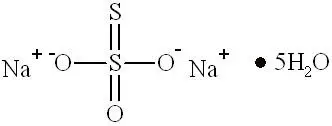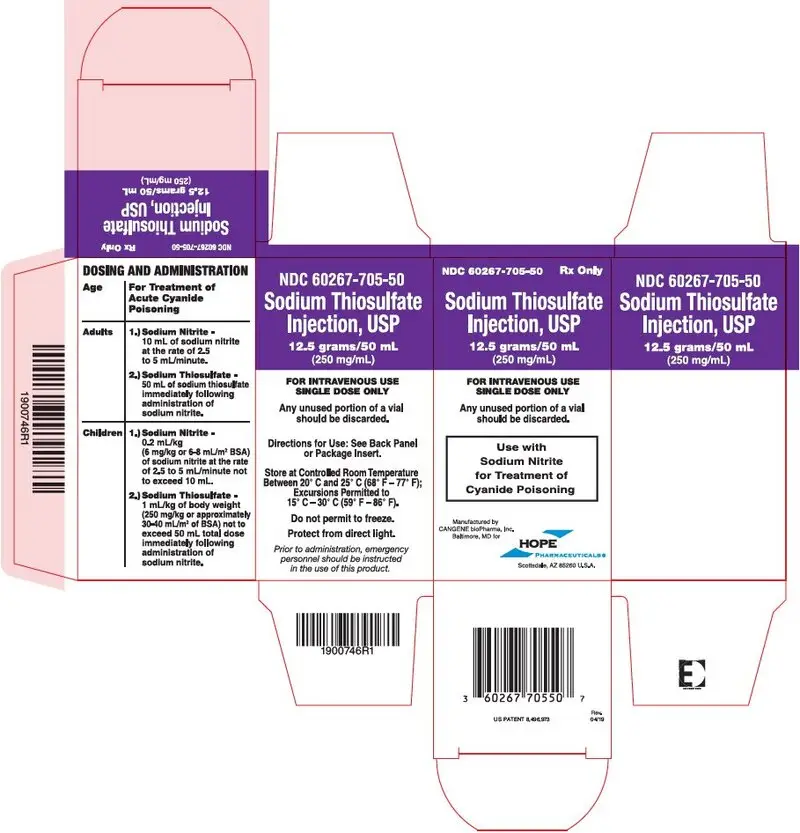Drug Detail:Sodium thiosulfate (antidote) (systemic) (monograph) (Medically reviewed)
Drug Class:
Highlights of Prescribing Information
Sodium Thiosulfate Injection, USP
Initial U.S. Approval: 1992
Indications and Usage for Sodium Thiosulfate Injection
Sodium Thiosulfate Injection, an antidote, is indicated for sequential use with sodium nitrite for treatment of acute cyanide poisoning that is judged to be serious or life-threatening. (1)
- Use with caution if the diagnosis of cyanide poisoning is uncertain. (1)
Sodium Thiosulfate Injection Dosage and Administration
- If clinical suspicion of cyanide poisoning is high, administer Sodium Thiosulfate Injection without delay and in conjunction with appropriate airway, ventilatory, and circulatory support. (2.1)
- The expert advice of a regional poison control center may be obtained by calling 1-800-222-1222. (2.1)
Dosing:
| Age | Intravenous Dose of Sodium Nitrite and Sodium Thiosulfate |
|---|---|
| Adults |
|
| Children |
|
- Redosing: If signs of cyanide poisoning reappear, repeat treatment using one-half the original dose of both sodium nitrite and sodium thiosulfate. (2.2)
- Monitoring: Blood pressure must be monitored during treatment. (2.2)
- Sodium thiosulfate is chemically incompatible with hydroxocobalamin and should not be administered via the same intravenous line. (2.4)
Dosage Forms and Strengths
Sodium Thiosulfate Injection consists of:
- One vial of sodium thiosulfate injection USP 12.5 grams/50 mL (250 mg/mL) (3)
Contraindications
- None. (4)
Warnings and Precautions
- Sulfites: Sodium thiosulfate may contain trace impurities of sodium sulfite (5.1)
Adverse Reactions/Side Effects
Most common adverse reactions are:
- Hypotension, headache, disorientation (6)
To report SUSPECTED ADVERSE REACTIONS, contact Hope Pharmaceuticals at 1-800-755-9595 or FDA at 1-800-FDA-1088 or www.fda.gov/medwatch.
Use In Specific Populations
- Lactation: Breastfeeding not recommended. (8.2)
- Renal impairment: Sodium thiosulfate is substantially excreted by the kidney. The risk of toxic reactions to this drug may be greater in patients with impaired renal function. (8.6).
See 17 for PATIENT COUNSELING INFORMATION.
Revised: 7/2020
Related/similar drugs
hydroxocobalamin, amyl nitrite, sodium thiosulfate, Cyanokit, NithiodoteFull Prescribing Information
1. Indications and Usage for Sodium Thiosulfate Injection
Sodium Thiosulfate Injection is indicated for sequential use with sodium nitrite for the treatment of acute cyanide poisoning that is judged to be serious or life-threatening. When the diagnosis of cyanide poisoning is uncertain, the potential risks associated with Sodium Thiosulfate Injection should be carefully weighed against the potential benefits, especially if the patient is not in extremis.
2. Sodium Thiosulfate Injection Dosage and Administration
2.1 Important Dosage and Administration Instructions
- If clinical suspicion of cyanide poisoning is high, administer Sodium Thiosulfate Injection without delay.
- Comprehensive treatment of acute cyanide intoxication requires support of vital functions. Administration of sodium nitrite and sodium thiosulfate should be considered adjunctive to appropriate supportive therapies. Airway, ventilatory and circulatory support, and oxygen administration should not be delayed in order to administer sodium nitrite and sodium thiosulfate [see Warnings and Precautions (5.1)].
- The expert advice of a regional poison control center may be obtained by calling 1-800-222-1222.
2.2 Recommended Dosing
Sodium Nitrite Injection and Sodium Thiosulfate Injection are administered by slow intravenous injection. They should be given as early as possible after a diagnosis of acute life-threatening cyanide poisoning has been established. Sodium nitrite should be administered first, followed immediately by sodium thiosulfate. Blood pressure must be monitored during infusion in both adults and children. The rate of infusion should be decreased if significant hypotension is noted.
| Age | Intravenous Dose of Sodium Nitrite and Sodium Thiosulfate |
|---|---|
| Adults |
|
| Children |
|
NOTE: If signs of poisoning reappear, repeat treatment using one-half the original dose of both sodium nitrite and sodium thiosulfate.
In adult and pediatric patients with known anemia, it is recommended that the dosage of sodium nitrite should be reduced proportionately to the hemoglobin concentration.
Visually inspect all parenteral drug products for particulate matter and discoloration prior to administration.
2.3 Recommended Monitoring
Patients should be monitored for at least 24-48 hours after Sodium Thiosulfate Injection administration for adequacy of oxygenation and perfusion and for recurrent signs and symptoms of cyanide toxicity. When possible, obtain hemoglobin/hematocrit when treatment is initiated. Measurements of oxygen saturation using standard pulse oximetry and calculated oxygen saturation values based on measured PO2 are unreliable in the presence of methemoglobinemia.
2.4 Incompatibility Information
Chemical incompatibility has been reported between Sodium Thiosulfate Injection and hydroxocobalamin and these drugs should not be administered simultaneously through the same IV line. No chemical incompatibility has been reported between sodium thiosulfate and sodium nitrite, when administered sequentially through the same IV line as described in Dosage and Administration.
Simultaneous administration of Sodium Thiosulfate Injection and blood products (whole blood, packed red cells, platelet concentrate and/or fresh frozen plasma) through the same intravenous line is not recommended. However, blood products and Sodium Thiosulfate Injection can be administered simultaneously using separate intravenous lines (preferably on contralateral extremities, if peripheral lines are being used).
3. Dosage Forms and Strengths
Sodium Thiosulfate Injection consists of:
- One vial of sodium thiosulfate injection USP 12.5 grams/50 mL (250 mg/mL)
Administration of one vial constitutes a single dose.
6. Adverse Reactions/Side Effects
There have been no controlled clinical trials conducted to systematically assess the adverse events profile of sodium thiosulfate.
The medical literature has reported the following adverse events in association with sodium thiosulfate administration. These adverse events were not reported in the context of controlled trials or with consistent monitoring and reporting methodologies for adverse events. Therefore, frequency of occurrence of these adverse events cannot be assessed.
Cardiovascular system: hypotension
Central nervous system: headache, disorientation
Gastrointestinal system: nausea, vomiting
Hematological: prolonged bleeding time
Body as a Whole: salty taste in mouth, warm sensation over body
In humans, rapid administration of concentrated solutions or solutions not freshly prepared, and administration of large doses of sodium thiosulfate have been associated with a higher incidence of nausea and vomiting. However, administration of 0.1 g sodium thiosulfate per pound up to a maximum of 15 g in a 10-15% solution over 10-15 minutes was associated with nausea and vomiting in 7 of 26 patients without concomitant cyanide intoxication.
In a series of 11 human subjects, a single intravenous infusion of 50 mL of 50% sodium thiosulfate was associated with increases in clotting time 1-3 days after administration. However, no significant changes were observed in other hematological parameters.
7. Drug Interactions
Formal drug interaction studies have not been conducted with Sodium Thiosulfate Injection.
8. Use In Specific Populations
8.4 Pediatric Use
There are case reports in the medical literature of sodium nitrite in conjunction with sodium thiosulfate being administered to pediatric patients with cyanide poisoning; however, there have been no clinical studies to evaluate the safety or efficacy of sodium thiosulfate in the pediatric population. As for adult patients, dosing recommendations for pediatric patients have been based on theoretical calculations of antidote detoxifying potential, extrapolation from animal experiments, and a small number of human case reports.
8.5 Geriatric Use
Sodium thiosulfate is known to be substantially excreted by the kidney, and the risk of adverse reactions to this drug may be greater in patients with impaired renal function. Because elderly patients are more likely to have decreased renal function, care should be taken in dose selection, and it may be useful to monitor renal function.
8.6 Renal Disease
Sodium thiosulfate is known to be substantially excreted by the kidney, and the risk of toxic reactions to this drug may be greater in patients with impaired renal function. Because elderly patients are more likely to have decreased renal function, care should be taken in dose selection, and it may be useful to monitor renal function.
10. Overdosage
There is limited information about the effects of large doses of sodium thiosulfate in humans. Oral administration of 3 g sodium thiosulfate per day for 1-2 weeks in humans resulted in reductions in room air arterial oxygen saturation to as low as 75%, which was due to a rightward shift in the oxygen hemoglobin dissociation curve. The subjects returned to baseline oxygen saturations 1 week after discontinuation of sodium thiosulfate. A single intravenous administration of 20 mL of 10% sodium thiosulfate reportedly did not change oxygen saturations.
11. Sodium Thiosulfate Injection Description
Sodium thiosulfate has the chemical name thiosulfuric acid, disodium salt, pentahydrate. The chemical formula is Na2S2O3∙ 5H2O and the molecular weight is 248.17. The structural formula is:
Structure of Sodium Thiosulfate Pentahydrate

Sodium Thiosulfate Injection is a cyanide antidote which contains one 50 mL glass vial containing a 25% solution of sodium thiosulfate injection.
Sodium thiosulfate injection is a sterile aqueous solution and is intended for intravenous injection. Each vial contains 12.5 grams of sodium thiosulfate in 50 mL solution (250 mg/mL). Each mL also contains 2.8 mg boric acid and 4.4 mg of potassium chloride. The pH of the solution is adjusted with boric acid and/or sodium hydroxide. Sodium thiosulfate injection is a clear solution with a pH between 7.5 and 9.0.
12. Sodium Thiosulfate Injection - Clinical Pharmacology
12.1 Mechanism of Action
Exposure to a high dose of cyanide can result in death within minutes due to the inhibition of cytochrome oxidase resulting in arrest of cellular respiration. Specifically, cyanide binds rapidly with cytochrome a3, a component of the cytochrome c oxidase complex in mitochondria. Inhibition of cytochrome a3 prevents the cell from using oxygen and forces anaerobic metabolism, resulting in lactate production, cellular hypoxia and metabolic acidosis. In massive acute cyanide poisoning, the mechanism of toxicity may involve other enzyme systems as well.
The synergy resulting from treatment of cyanide poisoning with the combination of sodium nitrite and sodium thiosulfate is the result of differences in their primary mechanisms of action as antidotes for cyanide poisoning.
12. 2 Pharmacodynamics
In dogs, pretreatment with sodium thiosulfate to achieve a steady state level of 2 μmol/mL increased the rate of conversion of cyanide to thiocyanate over 30-fold.
16. How is Sodium Thiosulfate Injection supplied
Each Sodium Thiosulfate carton (NDC 60267-705-50) consists of the following:
- One 50 mL glass vial of sodium thiosulfate injection 250 mg/mL (containing 12.5 grams of sodium thiosulfate);
| SODIUM THIOSULFATE
sodium thiosulfate injection, solution |
|||||||||||||||
|
|||||||||||||||
|
|||||||||||||||
|
|||||||||||||||
|
|||||||||||||||
|
|||||||||||||||
| Labeler - Hope Pharmaceuticals (015227945) |
| Establishment | |||
| Name | Address | ID/FEI | Business Operations |
|---|---|---|---|
| Curia Wisconsin, Inc. | 004670501 | API MANUFACTURE(60267-705) | |
| Establishment | |||
| Name | Address | ID/FEI | Business Operations |
|---|---|---|---|
| Cangene Biopharma, Inc. | 050783398 | MANUFACTURE(60267-705) | |
| Establishment | |||
| Name | Address | ID/FEI | Business Operations |
|---|---|---|---|
| Sterling Wisconsin LLC | 961717936 | API MANUFACTURE(60267-705) | |
| Establishment | |||
| Name | Address | ID/FEI | Business Operations |
|---|---|---|---|
| Curia New York, Inc. | 124193793 | API MANUFACTURE(60267-705) | |





